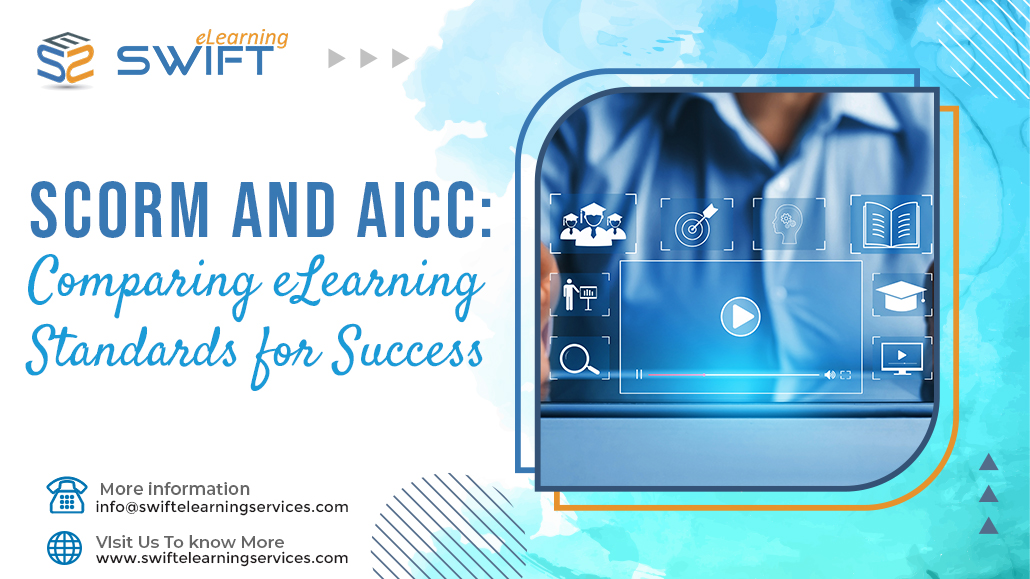SCORM and AICC: Comparing eLearning Standards for Success
In the ever-evolving landscape of eLearning, standards play a pivotal role in ensuring seamless compatibility and interoperability between learning management systems (LMS) and eLearning content. Among the array of standards available, SCORM (Sharable Content Object Reference Model) and AICC (Aviation Industry CBT Committee) have held significant prominence.
This article delves into the nuanced comparison of SCORM and AICC, highlighting their origins, technical attributes, adoption rates, flexibility, and cross-platform compatibility. By the end, you’ll have a comprehensive understanding of these two eLearning standards, aiding you in making informed decisions for eLearning content development.
1. Understanding SCORM and AICC
Both SCORM (Sharable Content Object Reference Model) and AICC (Aviation Industry CBT [Computer-Based Training] Committee) are eLearning standards designed to enhance the effectiveness and compatibility of learning content within various learning management systems (LMS). While they have their differences, both standards offer several benefits that contribute to the success of eLearning initiatives. Let’s explore the benefits of SCORM and AICC in detail:
2. Benefits of SCORM
Interoperability: SCORM ensures interoperability between different eLearning platforms and content. This means that content developed in compliance with SCORM can be seamlessly integrated into various LMS without compatibility issues.
Reusable Content: SCORM encourages the creation of reusable learning objects known as Sharable Content Objects (SCOs). These SCOs can be repurposed and reused in different courses, saving time and effort in content development.
Standardized Communication: SCORM employs a consistent set of communication protocols and APIs (Application Programming Interfaces) that facilitate the exchange of data between content and LMS. This standardization ensures uniform tracking and reporting of learner interactions, progress, and assessment results.
Tracking and Reporting: SCORM provides robust tracking and reporting capabilities. LMS can capture learner activities, interactions, time spent, and assessment scores, allowing instructors and administrators to monitor learner progress effectively.
Adaptive Learning: SCORM supports adaptive learning scenarios, where the content can adapt based on a learner’s interactions and responses. This personalized approach enhances engagement and promotes effective learning.
Flexibility: SCORM accommodates various content types, including multimedia, simulations, quizzes, and more. This flexibility allows content creators to design engaging and interactive learning experiences.
Cross-Platform Compatibility: SCORM-compliant content is compatible with a wide range of LMS platforms, ensuring consistent user experiences regardless of the chosen LMS.
Broad Industry Adoption: SCORM has gained widespread acceptance in the eLearning industry, leading to a wealth of resources, support, and tools for content creators and LMS providers.
Cost-Efficiency: Due to its compatibility and reusability, SCORM can lead to cost savings in content development and system integration.
3. Benefits of AICC
Early Industry Standard: AICC was one of the earliest eLearning standards, playing a crucial role in the aviation industry’s adoption of technology-based training. It laid the foundation for subsequent standards.
Structured Communication: AICC’s communication protocol, the HTTP AICC Communication Protocol (HACP), ensures a structured exchange of data between content and LMS. This facilitates tracking of learner interactions and progress.
Historical Significance: AICC’s historical significance cannot be ignored, especially in the aviation sector. It paved the way for the development of other standards and contributed to the growth of eLearning as a whole.
Learner Progress Tracking: AICC allows tracking of learner progress, providing insights into completed modules, time spent, and scores achieved. This tracking aids instructors in evaluating learners’ performance.
Certification and Compliance: In regulated industries like aviation, AICC compliance can be essential for meeting industry-specific training and certification requirements.
Focused Industries: AICC’s focus on aviation and CBT within certain sectors makes it a suitable choice for organizations in these specific industries.
LMS Integration: While AICC’s adoption has decreased over time, many legacy LMS systems still support AICC content, ensuring that existing courses remain functional.
Both SCORM and AICC offer distinct benefits that cater to different needs and contexts. SCORM’s widespread adoption, standardized communication, and cross-platform compatibility make it a robust choice for organizations seeking adaptable eLearning solutions.
On the other hand, AICC’s historical significance, compliance options, and compatibility with legacy systems can still be relevant in niche industries. When choosing between the two standards, organizations should consider their industry, specific requirements, available resources, and the technology landscape to make an informed decision that aligns with their goals and learners’ needs.
4. SCORM and AICC: Comparing eLearning Standards for Success
4.1 Origins and Evolution
SCORM: The evolution of SCORM can be traced back to the Advanced Distributed Learning (ADL) Initiative, a U.S. government program aimed at standardizing eLearning content for broad compatibility. Born out of the need to provide a unified framework for content creators, SCORM introduced a set of specifications that streamlined content packaging, deployment, and tracking within LMS environments. SCORM’s emphasis on interoperability and reusability propelled it to become a widely adopted standard.
AICC: In contrast, AICC has its roots in the aviation industry. The Aviation Industry CBT Committee established AICC to define guidelines for developing computer-based training (CBT) courses in the aviation sector. While AICC predated SCORM, it primarily gained traction within specific industries due to its early inception. However, as the eLearning landscape expanded beyond the aviation sector, its limitations became evident, spurring the search for more universal standards like SCORM.
4.2 Technical Comparison
SCORM: At the core of SCORM lies its robust technical framework that encompasses both content packaging and communication protocols. SCORM-compliant content is organized into Sharable Content Objects (SCOs), typically packaged within ZIP files. These SCOs comprise multimedia, HTML files, XML-based manifest files, and JavaScript components. SCORM’s communication protocol relies on JavaScript and API calls, enabling seamless interaction between the content and the LMS’s Run-Time Environment (RTE). This API-driven communication ensures efficient tracking of learner progress, interactions, and assessment results.
AICC: AICC’s technical approach centres on HTTP-based communication. Course packages in AICC consist of course structure files and content files, often including HTML-based elements and multimedia resources. The HTTP AICC Communication Protocol (HACP) facilitates the exchange of data between content and LMS. This protocol defines how data related to learner progress and interactions should be transmitted, allowing for tracking of performance within the course.
4.3 Adoption Rates and Industry Impact
SCORM: Over the years, SCORM has solidified its position as a leading eLearning standard. Its adaptability, widespread acceptance, and strong backing from major LMS vendors have contributed to its dominant status. Organizations across various industries have recognized SCORM’s potential to ensure compatibility among different systems, making it a go-to choice for content developers aiming to reach a broad audience.
AICC: While AICC initially held sway in the aviation industry and early eLearning systems, its adoption rates have dwindled over time. This decline can be attributed to its sector-specific focus and the emergence of more versatile standards like SCORM. Organizations seeking flexibility and cross-industry compatibility have gradually transitioned away from AICC in favour of standards with broader applicability.
4.4 Flexibility and Content Interaction
SCORM: One of SCORM’s key advantages lies in its flexibility. It accommodates dynamic interactions and allows for a higher degree of customization in terms of content presentation and tracking mechanisms. This adaptability empowers content creators to design engaging eLearning experiences that align with diverse learning needs.
AICC: While AICC serves its purpose well within specific contexts, its rigidity in terms of content structure and tracking methods limits the scope for dynamic interactions. Content creators may find it challenging to implement intricate eLearning experiences that demand more sophisticated interactions and customization.
4.5 Cross-Platform Compatibility
SCORM: SCORM’s widespread adoption has facilitated its seamless integration across a variety of platforms and technologies. This adaptability is a result of its compatibility with numerous LMSs and its support by industry leaders. SCORM-compliant content can be confidently deployed across different systems without concerns about compatibility issues.
AICC: Due to its specific origins and narrower adoption, AICC can face challenges when it comes to cross-platform compatibility. As technology advances and newer eLearning standards gain prominence, AICC may struggle to keep up with evolving platforms and technologies, potentially limiting its effectiveness in diverse eLearning environments.
5. Conclusion
In the dynamic realm of eLearning, standards like SCORM and AICC have left a lasting impact. While AICC’s early contributions cannot be disregarded, SCORM’s comprehensive technical framework, adaptability, and broader acceptance have propelled it to the forefront of eLearning standards.
The clear winner in the SCORM vs. AICC debate emerges as SCORM, with its capabilities extending across industries and its technical prowess aligning with the evolving eLearning landscape. As organizations continue to prioritize compatibility, interoperability, and dynamic content interactions, SCORM stands as the standard of choice, facilitating successful eLearning initiatives and fostering enhanced learning experiences.
Frequently Asked Questions (FAQs)
What is the origin of SCORM and AICC?
SCORM (Sharable Content Object Reference Model) was developed by the U.S. government’s Advanced Distributed Learning (ADL) Initiative to standardize eLearning content across platforms. AICC (Aviation Industry CBT Committee) emerged from the aviation industry to define guidelines for computer-based training courses.
How do SCORM and AICC differ in their technical approaches?
SCORM employs JavaScript and API calls for communication between content and LMS, packaged as Sharable Content Objects (SCOs). AICC uses HTTP-based communication with the HTTP AICC Communication Protocol (HACP) to exchange data between content and LMS.
What is the impact of SCORM’s adoption rates in the industry?
SCORM has gained widespread acceptance due to its adaptability and backing from major LMS vendors. Organizations from diverse sectors rely on SCORM for seamless compatibility among different systems.
Why did AICC’s adoption rates decline over time?
AICC’s decline in adoption can be attributed to its aviation-centric focus and the emergence of more versatile eLearning standards like SCORM. Its limitations in broader contexts hindered its universal applicability.
How does SCORM’s flexibility contribute to eLearning content development?
SCORM’s flexibility allows for dynamic interactions and content customization. Content creators can design engaging eLearning experiences with intricate scenarios, leveraging JavaScript-driven interactions and a comprehensive API structure.
What challenges does AICC face in terms of cross-platform compatibility?
Due to its specific origins and limited evolution, AICC might struggle to align with evolving platforms and technologies. This mismatch with modern eLearning ecosystems could limit its effectiveness and relevance.









Leave a Reply
Want to join the discussion?Feel free to contribute!